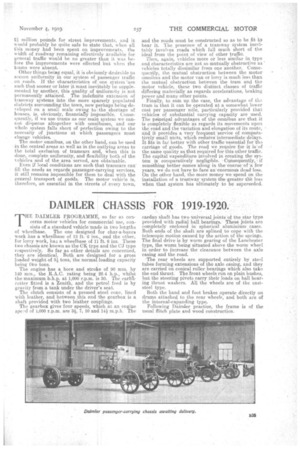DAIMLER CHASSIS FOR 1919-1920.
Page 13

If you've noticed an error in this article please click here to report it so we can fix it.
THE DAIMLER PAOGRANIME, so far as concerns motor vehicles for commercial use, consists of a standard vehicle:made in two lengths of wheelbase. The one designed for char-a-banes work has a wheelbase of 13 ft. 6 ins., and the other, for lorry work, has a wheelbase of 11 ft. 6 ins. These two chassis are known as the OK type and the CJ type respectively. So far as other details are concerned, they are identical. Both are designed for a gross loaded weight of 51 tons, the normal loading capacity being £Wo tons.
The engine has a bore and stroke of 90 mm. by 140 min., the R.A.C. rating being 22.4 h.p., whilst the maximum •b.h.p. at 1,000 r.p.m. is 30. The earnretter fitted is a Zenith, and the petrol feed is by gravity from a tank under the driver's seat.
The clutch consists of a pressed steel cone, lined with leather, and between this and the gearbox is a shaft provided with two leather couplings.
The gearbox gives four speeds, which at an engine aped of 1,000 r.p.ra. are a, 7, 10 and 1441 m.p.h. The cardan -.shaft has two universal joints of the star type provided with radial ball bearings. These joints are completely enclosed in spherical aluminium cases. Both ends of the shaft aro stained to cope with the telescopic motion caused by the action of the springs. The final drive is by worm gearing of the Lan-cheater type, the worm being situated above the worm wheel in order to increase the clearance between the axle casing and the road.
The rear wheels are supported entirely by steel tubes forming extensions of the axle easing; and they are carried on conical roller bearings which also take the end thrust. The. front wheels run on plain bushes, but the steering pivots carry their loads on ball bearing thrust washers. All the wheels arc of the caststeel type.
Bath the hand and foot brakes operate directly on drums attached to the rear wheels; and both are of the internal-expanding type.
Following Daimler practice, the frame is of the usual flitch plate and wood construction.


























